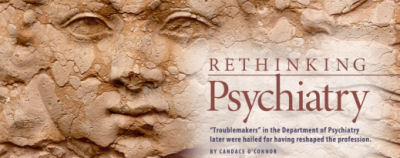| e e cummings
|
| Buffalo Bill’s defunct who used to ride a watersmooth-silver stallion and break onetwothreefourfive pigeonsjustlikethat Jesus he was a handsome man and what i want to know is how do you like your blueeyed boy Mister Death |
Outlook: Washington University, Saint Louis
February 2011In 2013, the American Psychiatric Association (APA) will publish the fifth edition of its Diagnostic and Statistical Manual of Mental Disorders, a thick, well-respected publication that contains the latest diagnostic criteria, drawn from rigorous scientific studies. But only a few decades ago, the slender DSM-II reflected a very different field, with vague definitions of psychiatric illnesses based on scanty scientific data. Everywhere, psychiatry departments were dominated by psychoanalysts, who focused on Freudian theory. “I remember one meeting, when I told a psychiatry professor about a study I had read showing that no two psychiatrists could agree better than chance on diagnosis,” says retired Washington University psychiatrist George E. Murphy, MD. “He said: ‘But then our diagnoses don’t mean anything,’ and I replied: ‘That’s exactly true.’ And he never spoke to me again, because that was too bitter a pill to swallow.”
In their profound disagreement with the psychoanalytic model — and their determination to forge a new, evidence-based brand of psychiatry — Washington University psychiatrists stood virtually alone. At scientific meetings, they were often shunned, their papers ignored; they faced rejection upon rejection in applying for research grants. But they persevered… Through their efforts, these university psychiatrists moved their field toward a new “medical model” of psychiatry that culminated in the publication of the DSM-III in 1980. For the first time, this psychiatric bible contained specific diagnostic criteria for all 200 categories of mental disorder — and omitted psychoanalytic concepts, such as “neurosis,” that had previously been part of the psychiatric lexicon…
In 1942, Washington University’s combined Department of Psychiatry and Neurology attracted a new head, Edwin F. Gildea, MD, a Yale psychiatrist and dedicated researcher. A Harvard colleague, Mandel Cohen, MD, was delighted at Gildea’s appointment. A staunch foe of psychoanalysis in a city dominated by analysts, Cohen was eager to spread his scientific approach, and he urged a talented protégé, Eli Robins, MD, to accept an appointment in Gildea’s department. Robins arrived at the university in 1949 with his wife, Lee Nelken Robins, PhD, later a key founder of psychiatric epidemiology. In 1954 came George Winokur, MD, a strident enemy of psychoanalysis, followed the next year by Samuel B. Guze, MD, a skilled internist who shifted to psychiatry. These three worked closely and collegially, joined by others: Murphy, Richard W. Hudgens, MD, Robert A. Woodruff Jr., MD, Paula J. Clayton, MD, Ferris N. Pitts, MD, Donald W. Goodwin, MD, and Rodrigo A. Muñoz, MD…
In the mid-1950s, Robins, Guze and Winokur persuaded Gildea to let them take over the educational aspects of the department; in 1963, Robins became head. Soon the three began making changes: Each resident would have to do some research. Residents, and eventually medical students, would learn an evidence-based approach to clinical psychiatry. “What are your data? That became the question. Freud would say something, and it became like Moses saying it,” says Hudgens, a 1956 graduate who returned in 1963. “There was a whole concept of orthodoxy in psychoanalysis. Well, here they didn’t have anything to do with that kind of ‘because I said so it’s so’ thinking.”
While using the latest clinical tools — medication, electro-convulsive therapy, psychotherapy — faculty members also embarked on groundbreaking research. Together, Robins and Murphy conducted a major study of suicide, but when they tried to publish the results in the American Journal of Psychiatry, the editor — a psychoanalyst — expunged all the diagnostic terms from the paper. “That would have ruined the paper,” says Murphy, “except that Eli was smarter than that, and he put the diagnostic terms in the legends for the figures and drawings. So we got it out there after all.”
In 1972, they achieved an important milestone: the publication of a seminal paper, “Diagnostic Criteria for Use in Psychiatric Research” by resident John P. Feighner, MD, et al., which established 15 major categories of diagnosis. Then a 1974 book — Psychiatric Diagnosis, written by Woodruff, Goodwin and Guze — further codified these ideas. Many Washington University residents took jobs around the country and became missionaries for this effort…
In the 1970s, psychiatrist Robert L. Spitzer, MD, of Columbia University, was asked to chair the APA task force charged with developing a DSM-III. Among its 19 members, he appointed five who had trained or taught at Washington University. With his colleagues, Spitzer, who had already worked with Eli Robins on expanding the Feighner categories, believed that the time had come for the use of operational criteria for psychiatric diagnosis. As successive drafts of the DSM-III made the rounds of the psychiatric community for field testing, the committee was surprised by the reaction. Few readers focused on the inclusion of diagnostic criteria; instead, they irately objected to the elimination of psychoanalytic concepts. However, the committee persisted and, with only a few compromises, the APA ratified the book’s publication…
Today, the Department of Psychiatry has ambitious plans on the horizon. Though DSM-V is in process, they are more focused on DSM-VI, some 15 years ahead. By then, they will have functional information about brain structures from a major brain-mapping project soon to be undertaken by David C. Van Essen, PhD, professor and head of anatomy and neurobiology. Through his work, they hope to understand the breakdown of brain systems in psychiatric disorders and design targeted therapies to treat them. “Our job — what we have inherited — is to be trouble-makers, and I like that,” says Zorumski. “We want to keep reminding people that we haven’t done enough and to keep asking: ‘Where is the next thing coming from?’”


I had very cordial relationships with all these Washington University people, especially George Winokur, Paula Clayton, and Sam Guze. They were grownups who could tolerate disagreements. They also had intellectual flexibility, meaning they could let go of a favorite idea if the data came in contrary to their original thinking.
One of Sam Guze’s seminal ideas was to draw the parallel between systemic lupus erythematosus and depression. He emphasized that SLE was originally recognized as a fulminant autoimmune condition but that the advent of biomarkers like RA factor and anti-DNA antibodies educated us to the unsuspected prevalence of milder and subclinical cases. Sam drew the parallel between this autoimmune epidemiology and the spectrum of depressive disorders.
George Winokur cheerfully gave up his investment in his proposal of Depression Spectrum Disease when data like our DST studies in psychotic depression failed to support it.
Paula Clayton’s entire career at St. Louis and then at Minnesota is a testament to pragmatic respect for the data rather than commitment to predetermined models.
I am not sure that I buy Chuck Zorumski’s blue-skying about future breakthroughs. But the St. Louis people have been leaders in questioning the status quo for 40 years.
I don’t question the Founding Fathers. It’s the Latter Day Saints that have been the problem. I wish we had some people thinking like the people you describe on the front row right now – questioning the current status quo…